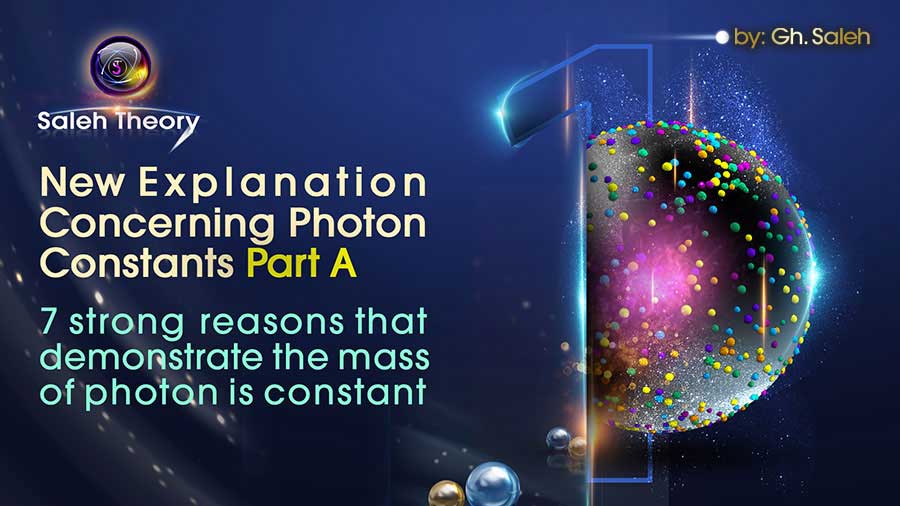
New Explanation Concerning Photon Constants Part A
7 strong reasons that demonstrate the mass of photon is constant
From ancient, physics was named the science of measurement. The measurement in photoelectric effect proved that the light must be consisted of particles and the reason for the refusal of that was the double-slit experiment. In the double-slit experiment, we could observe interference fringes that justify the light as a wave. But we know that the constant mass of the electron was proven and have interference fringes in the double-slit experiment too. Therefore, there is at least one example with constant rest mass which has interference fringes in double-slit experiment. So, the removal of constant rest mass, for photon, is not a good solution to answer the observance of interference fringes in double-slit experiment. In this paper, we explain four real examples in different branches of physics based on a new theory, Saleh Theory, which known a photon as a small particle with constant rest mass. The compare was shown to determination of a violation in the Conservation of mass and energy principle. This indicates that where the photon rest mass is zero the mass and energy principle is violated and demonstrate that we need to use a new theory to improve all physics’ branches which encounter with photons.
1. Considering that each photon emits from an electron, and the mass of all electrons is identical and constant, so:

Furthermore, the velocity of electrons is also constant. Consequently, if a photon emits from an electron, it will not differ from other photons, and therefore the mass of photons, as a physical parameter, will be equal:

2. The evanescent wave intensity is indeed mostly localized within 1 μm from the fiber surface. The penetration depth (dp) is a parameter represent the depth at which the electric field drops to 1/e of its initial value at the surface. The dp is a function which is depended to the refractive index as well as the wavelength of the propagating light, and the angle in which the incidence wave moves in the fiber. The penetration depth of the evanescent waves has a linear relativity with the wavelength. The wavelength dependence of depth can be estimated, as shown in figure 1. Also, data obtained in the other previous experimental study show a compilation plot (Figure 2). In this experiment the calculated penetration depth and detection threshold for a range of excitation wavelengths is measured for several types of polymer microspheres over the same range of wavelengths.
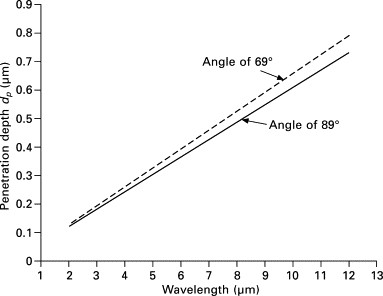
Fig. 1. The relationship between penetration depth and wavelength.
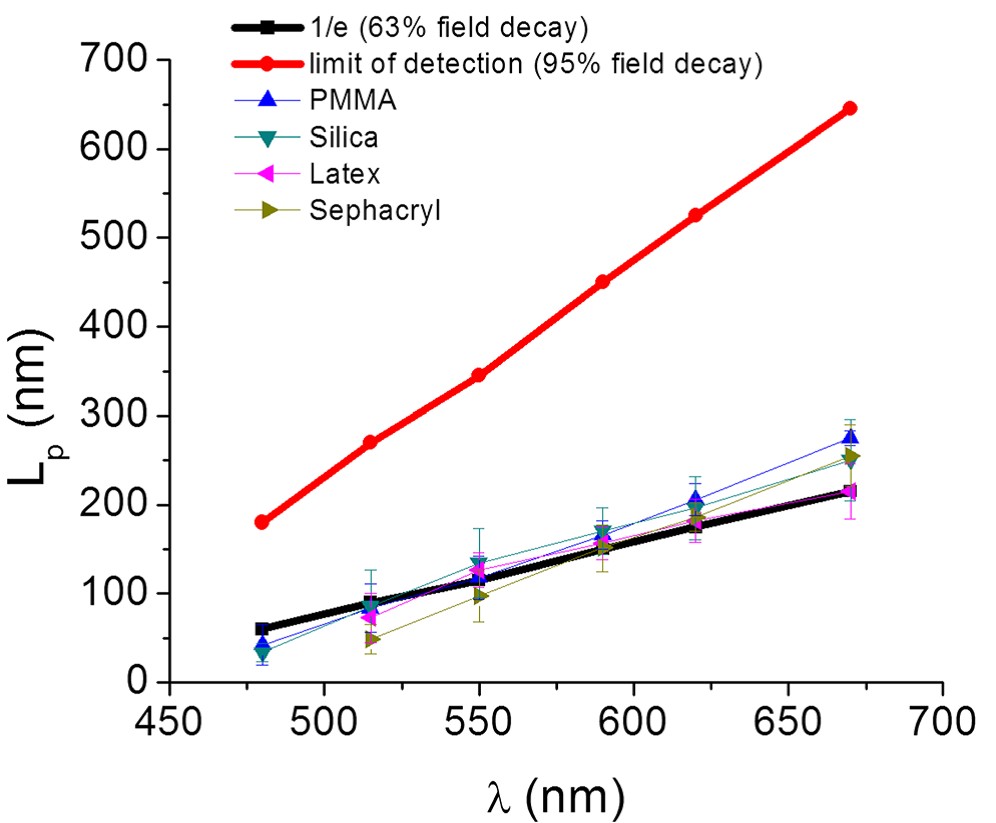
Fig. 2. The relationship between evanescence and wavelength.
These two shows that the spectrums with longer wavelength have longer penetration dp. But the spectrum with longer wavelength has lower energy and the longer penetration dp needs higher energy, so the spectrum with lower energy could penetrate more in fiber optics or in polymer microsphere. It is also another contradiction.
3. Given that the method for calculating the energy of photons involves using Planck's ever-valid relation (E=hf) – where h is a constant (Planck's constant) and f is the frequency, and changes in frequency (wavelength, radius of rotation, and amplitude) are the influential variables for calculating photon energy, with the mass parameter never affecting this equation – it can be concluded that the mass of a photon must be always constant.
4. Data obtained in previous studies indicated that the performance of solar cells is dependent to wavelengths of light. The investigation, about the performance of a solar photovoltaic module, shows that the wavelength of light is the most important factor. After analyzing the results, it was concluded that the wavelengths of light do affect the performance of solar cells. Light spectrum with longer wavelength (Red color) generates more electricity than shorter ones (Violet color). Although longer wavelengths of visible light have less photon energy but they are more efficient than shorter wavelengths in photovoltaic cells.
This analyses, demonstrate that the red spectrum with lower mass and lower energy could generate more electricity than violet one. And we know that more electricity means more energy. So, the red spectrum with lower mass and energy produces more electrical energy. That violates the Conservation of mass and energy and it is a big contradiction.
5. Here we explain the relationship between temperature of a cavity and the wavelength of the emitted spectrum of a solid-state laser. Previous studies have shown a linear relationship between the emitted wavelength and temperature of a laser diode. Here we explain the experiment about Resonantly Pumped W-OPIC Laser. In this experiment the Wavelength Spectrum of a Resonantly Pumped W-OPIC Laser depended on the Temperature of the cavity. When we increased the temperature of the sample in the laser, the wavelength emitted from the sample cavity increases.
On the other hand, regarding the second law of thermodynamics the energy which stored in a hot container (higher temperature) in comparison with the energy stored in a cold container (at lower temperatures) has a higher ability to work.
This experiment shows that the spectrums with longer wavelength will emit from the higher temperature cavity. But regarding the Planck law the spectrum with longer wavelength has lower energy and the higher temperature cavity means higher energy, so the spectrum with lower energy will emit from cavity with higher energy and vice versa. It is a big contradiction.
6. In previous articles, we have described different velocities for the photon and proved that the various types of a photon's velocity – linear, wave-like, rotational, etc. – are always constant. As a result, it can be said that the mass of photons will be constant. This is because a photon emitting from an electron undergoes a projectile motion, which transfers a specific and constant energy to the photon, propelling it into its surroundings. Consequently, since the photon's velocity will be constant everywhere, its mass must be constant too.
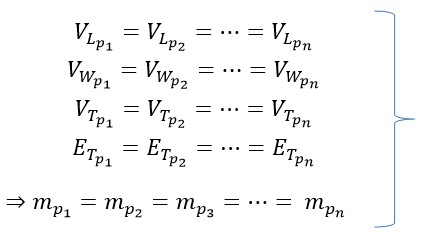
7. Redshift and Blueshift are the important phenomenon in Astronomy. Here we speak about Redshift but Blueshift also is the same. When a source (star) which producing the blue spectrum moves away from us, we perceive it as red. So, in Redshift the wavelength will increase. Therefore, in Redshift (Blueshift) the star generates a wavelength, but we receive another wavelength. Regarding the change of wavelength is equivalent to a photon’s mass and energy. It means in vacuum the energy we perceive has a lower amount than it emitted. Although somebody tried to solve the problem like this: “… redshifts, by increasing wavelengths, must reduce the energy in the quanta. Any plausible interpretation of redshifts must account for the loss of energy.” but there is not logical and experimental enough to accept. And there is another contradiction.
Conclusion:
Based on the explanations above, it could generally be stated that the photon is a stable particle with a constant mass. So, according to Saleh Theory the mass of all different photons are the same. But rotational energy (inner part of the kinetic energy) of red spectrum is higher than violet one and “wave part of the kinetic energy” of red spectrum is lower than the violet one.
References:
[1] van der Merwe, A., and Selleri, F. Quantum Paradoxes and Physical Reality. Kluwer Academic Publishers, 1990.
[2] Descartes, R., and Gaukroger, S., editors. Descartes: The World and Other Writings. Cambridge University Press, 1998, pp. 3–75.
[3] Fisher, S. "Stanford Encyclopedia of Philosophy." 2009.
[4] Smith, G. "The Stanford Encyclopedia of Philosophy." Edited by E. N. Zalta, Metaphysics Research Lab, Stanford University, 2007.
[5] Huygens, C. Treatise on Light. Translated by Silvanus P. Thompson, Macmillan, 1912.
[6] Pedrotti, F. L., and Pedrotti, L. S. Introduction to Optics. Prentice Hall, 1993.
[7] Planck, M. "Über das Gesetz der Energieverteilung im Normalspektrum." Annalen der Physik, 1901.
[8] Weidner, R. T., and Sells, R. L. Elementary Modern Physics. Allyn and Bacon, 1973.
[9] de Broglie, L. Une interprétation causale et non linéaire de la mécanique ondulatoire: la théorie de la double solution. Gauthier-Villars, 1956.
[10] de Broglie, L., and Brillouin, L. Selected Papers on Wave Mechanics. Blackie & Sons Limited, 1928.
[11] de Broglie, L., and Mechanics, N.-L. W. A Causal Interpretation. Elsevier, 1960.
[12] Giancoli, D. C. Physics for Scientists and Engineers with Modern Physics. Pearson Education, 2009.
[13] Gaab, K. M., and Bardeen, C. J. "Wavelength and Temperature Dependence of the Femtosecond Pump−Probe Anisotropies in the Conjugated Polymer MEH-PPV: Implications for Energy-Transfer Dynamics." The Journal of Physical Chemistry B, vol. 108, 2004, pp. 4619–4626.
[14] Ogherohwo, E., Barnabas, B., and Alafiatayo, A. "Investigating the Wavelength of Light and Its Effects on the Performance of a Solar Photovoltaic Module." International Journal of Innovative Research in Computer Science & Technology (IJIRCST), vol. 3, 2015, pp. 61–65.
[15] Peterson, A. W., Halter, M., Tona, A., and Plant, A. L. "High Resolution Surface Plasmon Resonance Imaging for Single Cells." BMC Cell Biology, vol. 15, 2014, article 35.
[17] Zemansky, M. W., and Dittman, R. Heat and Thermodynamics. McGraw-Hill, 1981.
[18] Pecker, J.-C. "Possible Explanations of Non Cosmological Redshift." International Astronomical Union Colloquium, no. 37, 1977, pp. 451–479.
[19] Benitez, N. "Bayesian Photometric Redshift Estimation." The Astrophysical Journal, vol. 536, 2000, pp. 571–583.
[21] Ligler, F. S., and Taitt, C. R. Optical Biosensors: Today and Tomorrow. Elsevier Science, 2008.
[22] Harrick, N. J. Internal Reflection Spectroscopy. 1967.
[24] Le Roux, Francis, Hatefi, Shahrokh, Abou-El-Hossein, Khaled, Van Niekerk, Theo, and Hatefi, Katayoun. "Design of Rechargeable Battery System for Mandibular Distraction Osteogenesis Device." International Journal of Electrical and Electronic Engineering & Telecommunications, vol. 9, no. 2, Mar. 2020, pp. 117–123. doi:10.18178/ijeetc.9.2.117-123.
[25] Ryu, Anto, Ishii, Hideo, and Hayashi, Yasuhiro. "Multi-Objective Optimal Operation Planning for Battery Energy Storage in a Grid-Connected Micro-Grid." International Journal of Electrical and Electronic Engineering & Telecommunications, vol. 9, no. 3, May 2020, pp. 163–170. doi:10.18178/ijeetc.9.3.163-170.
[26] Wong, Ling Ai, and Ramachandaramurthy, Vigna K. "Optimal Battery Energy Storage System Placement using Whale Optimization Algorithm." International Journal of Electrical and Electronic Engineering & Telecommunications, vol. 9, no. 4, July 2020, pp. 268–272. doi:10.18178/ijeetc.9.4.268-272.
[27] Kusakana, Kanzumba. "Optimal Energy Management of a Double-Tracking Grid-Connected Photovoltaic with Battery System for a Microbrewery." International Journal of Electrical and Electronic Engineering & Telecommunications, vol. 10, no. 2, Mar. 2021, pp. 133–138. doi:10.18178/ijeetc.10.2.133-138.
[28] Sibiya, Cyncol A., Numbi, Bubele P., and Kusakana, Kanzumba. "Modelling and Simulation of a Hybrid Renewable/Battery System Powering a Cathodic Protection Unit." International Journal of Electrical and Electronic Engineering & Telecommunications, vol. 10, no. 3, May 2021, pp. 203–208. doi:10.18178/ijeetc.10.3.203-208.
[29] Saleh, Gh. "New Proof of Photon Velocity (VT = 3.3 C) Utilising Mathematical Equations, Physical Laws and the Experiments of MIT and Michigan University in the Universe 2025 Part A." Saleh Theory, 26 Apr. 2025, https://www.saleh-theory.com/article/a-new-proof-of-photon-velocity-vsubtsub-33-c-utilising-mathematical-equations-physical-laws-and-the-experiments-of-mit-and-michigan-university-in-the-universe-2025-part-a
[30] Saleh, Gh. "New Proof of Photon Velocity (VT = 3.3 C) Utilising Ever-True Planck Energy Equation and Kinetic Energy Equation in the Universe 2025 Part B." Saleh Theory, 03 May 2025, https://www.saleh-theory.com/article/a-new-proof-of-photon-velocity-vsubtsub-33-c-utilising-ever-true-planck-energy-equation-and-kinetic-energy-equation-in-the-universe-2025-part-b
[31] Saleh, Gh. "New Proof of Photon Velocity (VT = 3.3 C) Utilising the Young's Double-Slit Experiment and the Motional Model of Emitted Photons from Electrons in the Universe 2025 Part C." Saleh Theory, 03 May 2025, https://www.saleh-theory.com/article/a-new-proof-of-photon-velocity-vsubtsub-33-c-utilising-the-youngs-double-slit-experiment-and-the-motional-model-of-emitted-photons-from-electrons-in-the-universe-2025-part-c
[32] Saleh, Gh. "A New Proof of the Constancy of Photon Mass Using Its Initial Energy." Saleh Theory, 06 Mar. 2025, https://www.saleh-theory.com/article/a-new-proof-of-the-constancy-of-photon-mass-using-its-initial-energy
[33] Saleh, Gh. "New, Marvelous and Revolutionary Discoveries About Photon." Saleh Theory, 07 Sep. 2023, https://www.saleh-theory.com/article/new-marvelous-and-revolutionary-discoveries-about-photon
[39] Saleh, Gh. "Photon has a Constant Rest Mass!." Saleh Theory, 16 Mar. 2018, https://www.saleh-theory.com/article/photon-has-a-constant-rest-mass
[40] Saleh, Gh. "A Revolution in Light Theory." Saleh Theory, 11 Apr. 2017, https://www.saleh-theory.com/article/a-revolution-in-light-theory
 Download PDF
Download PDF Articles
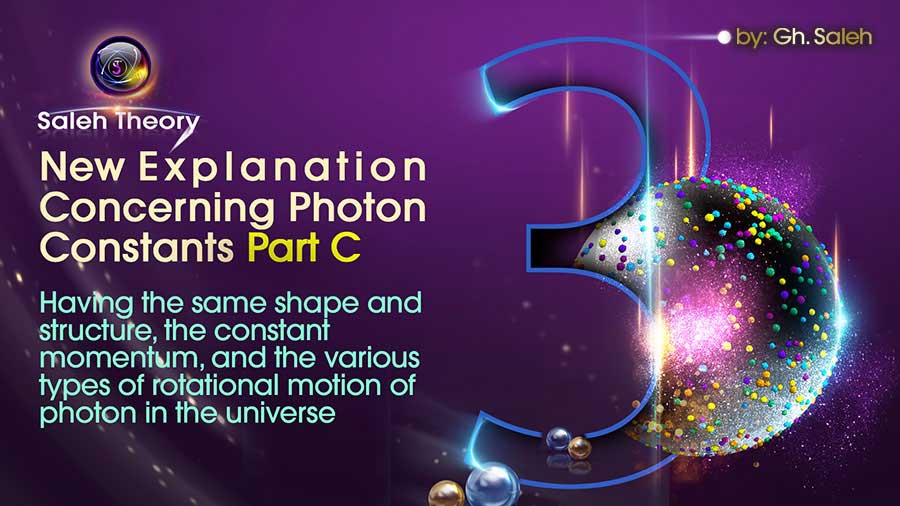
Having the same shape and structure, the constant momentum, and the various types of rotational motion of photon in the universe
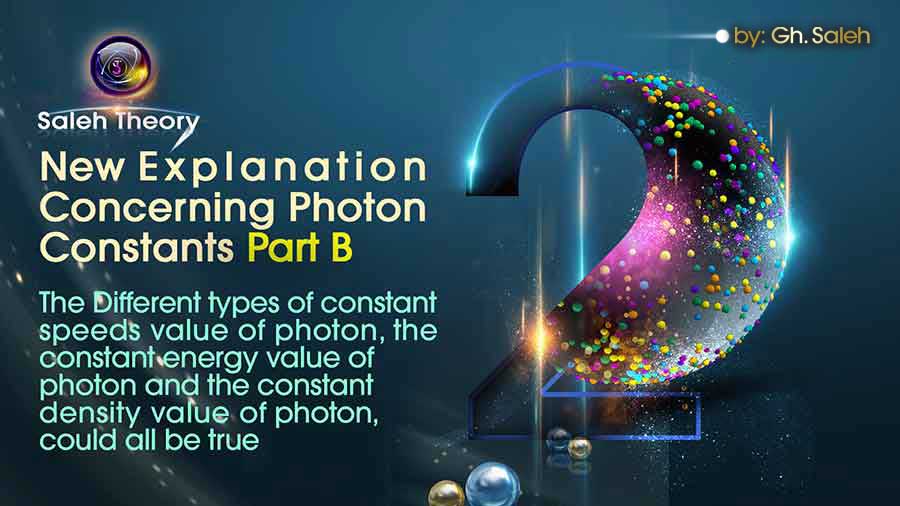
The different types of constant speeds value of photon, the constant energy value of photon and the constant density value of photon, could all be true
